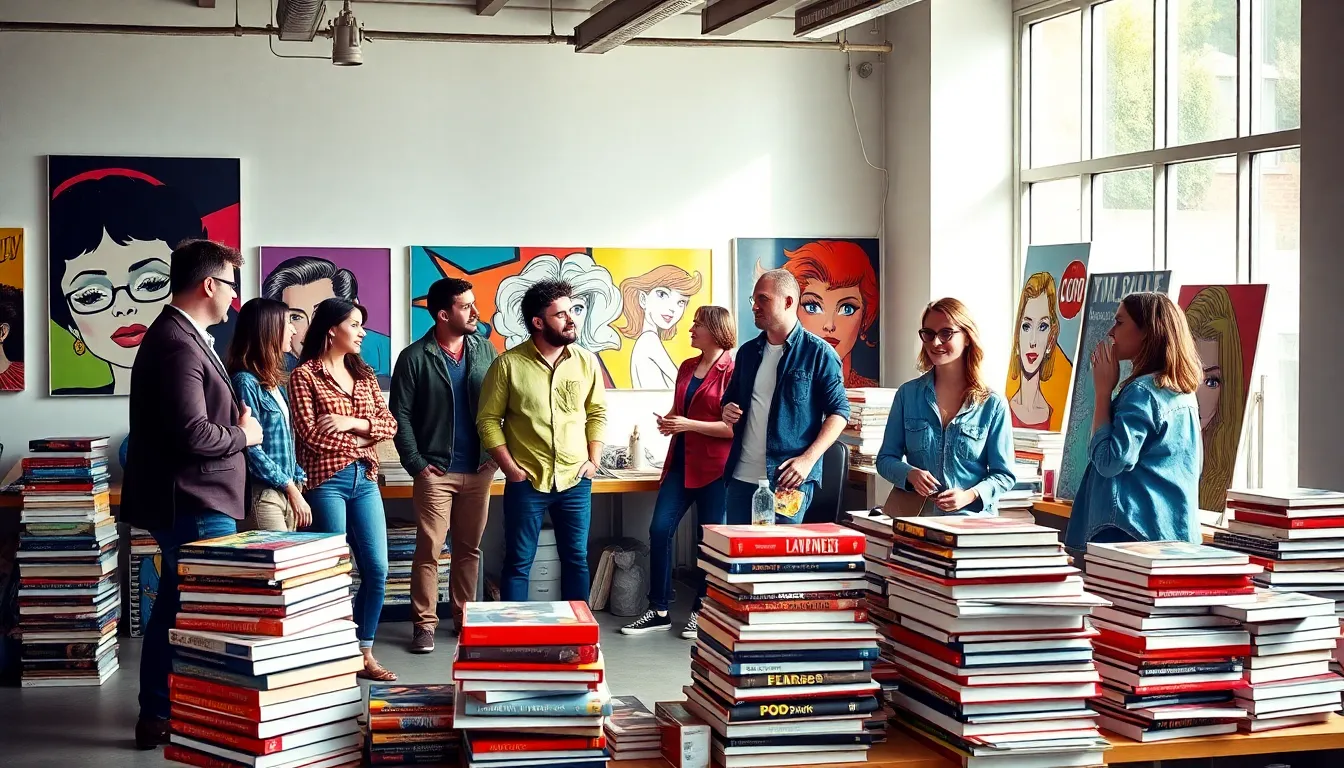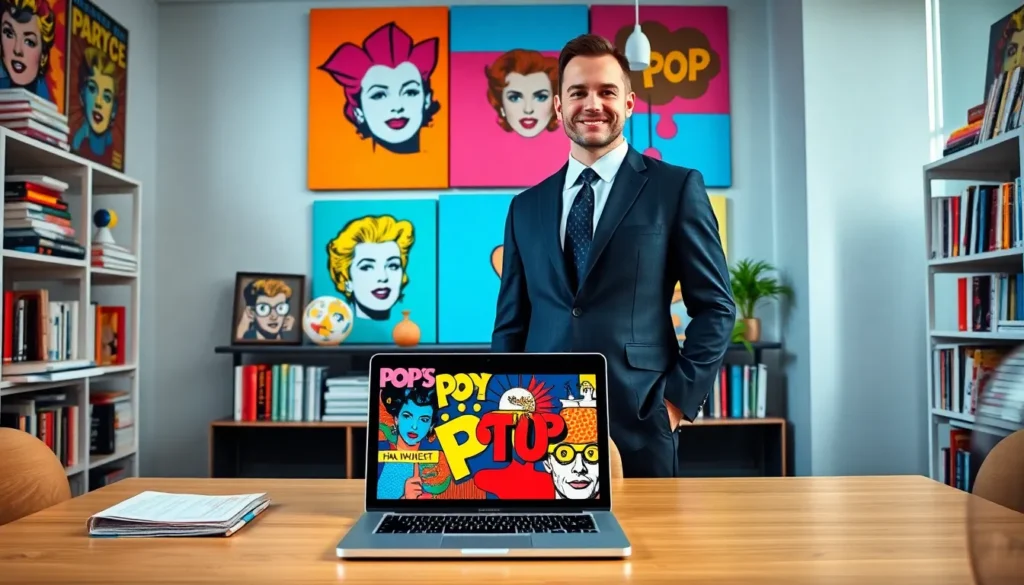Table of Contents
TogglePop art has always been a rebellious teenager in the world of art, an audacious blend of highbrow culture and everyday life, kicking tradition to the curb. Imagine a world where comic strips and celebrity portraits strut into museums, throwing a party that literature wanted to crash. As this vibrant art movement continues to evolve, pop art books serve as a delightful bridge, connecting visual aesthetics to the written word. In this text, we’ll dive deep into the colorful universe of pop art literature, understanding its roots, its cultural significance, and how it remains relevant today. Let’s uncover the joy, the irony, and the pure chaos that is pop art books.
Understanding Pop Art: Origins and Characteristics

Pop art emerged in the 1950s as a response to the rising consumer culture and mass media. Influenced by a myriad of sources, from comic books to advertisements, this movement sought to challenge traditional distinctions between ‘fine’ art and the popular imagery of everyday life. Artists like Andy Warhol and Roy Lichtenstein turned mundane objects into masterpieces, provoking thought about the nature of art itself.
The characteristics of pop art are instantly recognizable. Bold colors, familiar imagery, and an element of humor frequently define this visual style. The use of commercial techniques like screen printing and collage blurred the lines between art and commercial culture. Artists adopted a tongue-in-cheek approach, often incorporating irony and satire, which compelled viewers to reflect on their relationships with consumer goods and the media.
So, pop art is more than just striking visuals: it embodies cultural commentary and critique, making literature it’s perfect counterpart.
The Role of Literature in Pop Art
Literature has played a vital role in the pop art movement, often acting as a muse for many artists. Think about it, how can one not be inspired by the narratives strewn across magazine pages or newspapers? Works of literature have influenced the themes and motifs explored by pop artists.
Take, for instance, the way novels and poems have captured popular culture over the decades. Some pop artists have visualized the words, creating a dialogue between the written and the visual. This interplay stimulates a richer understanding of art and culture. Verses from famous poems may appear alongside vibrant images, inviting discussion about the deeper meanings behind the visuals.
Also, literature’s accessibility complements pop art’s ethos. Just as certain pieces of pop art can be enjoyed by anyone, from a seasoned critic to children at a birthday party, so too can classic and contemporary literature. This shared accessibility is foundational in creating a culture where high art and popular literature coexist harmoniously.
Iconic Pop Art Books and Their Impact
Several books have successfully encapsulated pop art’s spirit while making substantial contributions to its evolution. One standout is “Andy Warhol: A Biography” by Victor Bockris. This work offers a glimpse into the life of one of the genre’s forefathers. Bockris details Warhol’s vision of transforming everyday images into fine art, reinforcing the notion that art can stem from the mundane.
Another essential read is “Popism: The Warhol Sixties,” where Warhol and co-author Pat Hackett unravel pop culture and art’s intersection during a revolutionary time. The candid portrayal of the 1960s art scene provides context while celebrating the glamour and chaos that infused art and literature alike.
Finally, “The New York School: The Second Generation” offers insights into how pop art influenced and was influenced by the literary world. This compilation showcases how authors and poets were often in dialogue with their visual counterparts, further solidifying the relationship between words and images. These influential texts have undoubtedly shaped perceptions and fueled discussions around the pop art movement.
Exploring the Cultural Significance of Pop Art
Pop art holds a mirror to society, reflecting its values, obsessions, and contradictions. This culture of appropriation and remixing, challenging the authenticity of art, stands at the heart of pop art’s cultural significance. It prompts questions about what constitutes art in the age of mechanical reproduction.
As society evolves, so does pop art. Whether addressing consumerism, celebrity culture, or politics, pop art remains deeply intertwined with societal themes. It’s a genre that continues to engage with issues relevant today, not just through visual art but through literature that comments on modern phenomena.
Also, pop art’s embrace of all things popular has brought marginalized voices to the forefront. Artists who might otherwise go unnoticed have found a home within the pop art movement, allowing them to showcase their perspectives and narratives alongside well-known figures. This inclusive nature celebrates diversity, making pop art a vibrant reflection of contemporary culture.
Pop Art in Contemporary Literature
The dynamic essence of pop art transcends the visual realm, strongly influencing contemporary literature. Authors today often employ techniques drawn from pop art aesthetics to challenge norms and express their narratives. For example, the use of fragmented storytelling mimics the collage techniques of pop artists, creating an engaging reading experience.
Books like “White Teeth” by Zadie Smith showcase these techniques further. Here, Smith’s layered narrative draws on various pop culture references, creating a rich tapestry that mirrors the multidimensional character of pop art itself. The influence of pop art can also be seen in newer genres such as graphic novels, where the fusion of visual art and text has led to a renaissance in storytelling.
Contemporary poets have also incorporated pop art elements into their work. By weaving cultural references into their verses, they evoke emotions while tapping into a collective consciousness shaped by mass media and imagery. This intertwining of art forms creates a lively discourse that captivates audiences, reminding them of the joy and absurdity of modern life.
Collecting Pop Art Books: Tips and Resources
For those looking to jump into the world of pop art books, several resources can help smooth the journey. Start by attending art fairs and book festivals where pop art literature is often highlighted. This is where enthusiasts can meet fellow collectors, artists, and authors, creating a lively community centered on shared passions.
Also, consider exploring online marketplaces like eBay or AbeBooks, which can yield rare finds at reasonable prices. Websites dedicated to art books often host secondhand sales and auctions. These platforms can be treasure troves of hard-to-find texts.
Visits to local bookstores and independent shops should not be overlooked. These venues often curate unique selections that reflect the regional art scene. Plus, engaging in conversations with shop owners can uncover hidden gems. Finally, library databases can provide access to extensive archives of both contemporary and classic pop art literature, so diving into research is easier than ever.




